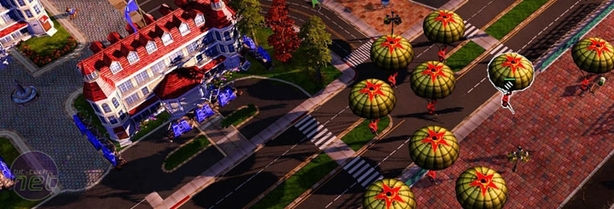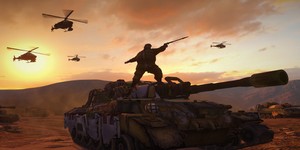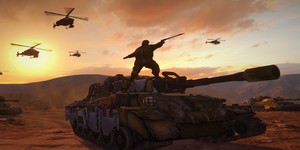
Multiplayer
Multiplayer is one of the most important things about the Command and Conquer series, which we suppose makes it kind of weird to hire so many actors and spend so much time and effort on the singleplayer side of things.I mean Jenny McCarthy, George Takei, Tim Curry, Gemma Atkinson and J.K Simmons may not cost much – but That Girl Who Played Le Chiffre’s girlfriend In Casino Royale? That’s the level of talent that costs serious moolah.
The multiplayer in Red Alert 3 though hasn’t been neglected, thankfully. There are still plenty of maps to play on, ranging from the quick and simple skirmishes for two or three players right through to maps more suited to complex power-plays and fragile alliances that can make or break a LAN party.
The lobby system, while not perfect, is capable enough to keep the action going and the it’s fairly easy for players to drop in, choose a faction and join the battle. One thing that is lacking though is a full set of tweakable rules.
Hosts can choose the amount of credits for each player to start with and whether or not they want bonus crates to drop throughout the game, but that’s it. There’s no real option to disbar certain superweapons or limit the tech-tree; such things rely more on player agreements and courtesy rather than in-game capacity.
That said, you wouldn’t really want to limit the tech tree anyway as it’s fairly basic on its own. There’s literally nothing above or beyond the examples we gave earlier. A barracks will net you the basic infantry and the battle lab will bring two more units to the table, but that’s it.
For the singleplayer game, that isn’t a huge problem as your amount of capital is determined by the level design and the fact that you have to split it all 50-50 with your co-op team mate. In multiplayer however, when your amount of money is defined at the start of the game by the host and how many engineers you can plant in refineries throughout the level, you run out of new units to build very quickly.
There’s also the problem of superweapons and rushes to bear in mind. On the side of the superweapons, the news is good as even the most powerful devices still aren’t game-deciding. Most attacks are enough to take out a building or two, but it isn’t going to obliterate absolutely everything, so the game is more a matter of strategy than a race to see who can build an iron curtain first.
There is still a case of the ol’ balancing blues too and while tank rushes are far less of an issue than they were in some of the older games, they’ve only been replaced by slightly more subversive tactics.
Engineers then are the new Tanks as they can be built fast, cheaply and easily. They can travel over land or water and do so at a reasonable rate. It’s all too easy for most players to just send a dozen or so engineers at the enemy and let them capture and sell the enemy bases. Infantry turrets will promise a certain amount of defense – but they build much slower and so have to be carefully positioned.
Granted, this isn’t a tactic that’s going to daunt the pros – a helicopter or two is enough to hunt down and riddle the brainiest engineer with bullets, but this is a fairly obvious tactic not to have been closed and could definitely annoy some beginners or newcomers to the game.
Oh, it’s also worth bearing in mind that Red Alert 3 has a framerate cap of 30 frames per second again. This is going to be good news for those with lesser systems as it means that their more powerful brethren won’t be able to squeeze a technical advantage out of the system, though there is a minority out there which insists it makes the game a bit stuttery. We don’t buy that argument personally, but we are annoyed it makes the game useless for benchmarking with.

MSI MPG Velox 100R Chassis Review
October 14 2021 | 15:04











Want to comment? Please log in.